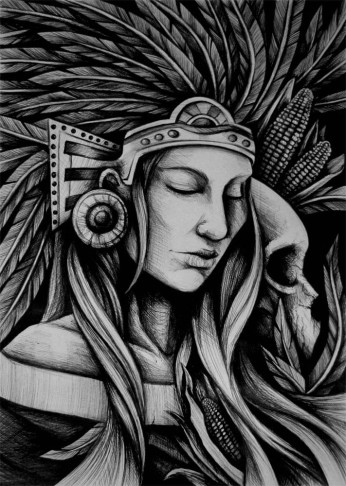“Çhicomecoatl’s themes are fire, providence, energy, community, abundance, fertility and strength. Her symbols are hot spices (especially chili peppers), corn and fire. In Mexico, this Goddess presides over maize and all matters of plenty during this time of harvest. Çhicomecoatl is also the hearth Goddess and provides warmth, energy and fertility in those in need. Her fiery, strong character is depicted vibrantly in artistic renderings in which Çhicomecoatl bears the sun as a shield.
Around this time of year, people in New Mexico celebrate The Whole Enchilada Festival in which they enjoy a day of taste-testing a ten-foot-long enchilada in a communal atmosphere, and you might like to follow suit. The hot spices in enchiladas (or other Mexican foods you like) motivate Çhicomecoatl’s fire within for physical and emotional warmth. If you’re sensitive to hot peppers, add corn to your diet today instead. This invokes the Goddess’s strength and fertility.
More simply still, Çhicomecoatl abides in any fire source. So, light a candle first thing in the morning to welcome Her into your home today. For portable magic, carry matches or put a lighter in your pocket. Throughout the day, light a match or the lighter when ever you need a boost of energy or vitality, or when you need to improve your communications with those around you. This action also draws Çhicomecoatl’s attention to your financial needs.”
(Patricia Telesco, “365 Goddess: a daily guide to the magic and inspiration of the goddess”.)
“In Aztec mythology, Chicomecōātl (‘Seven snakes’), was the Aztec Goddess of agriculture during the Middle Culture period. She is sometimes called ‘Goddess of nourishment’, a Goddess of plenty and the female aspect of corn. Every September a young girl representing Chicomecōātl was sacrificed. The priests decapitated the girl, collected her blood and poured it over a figurine of the Goddess. The corpse was then flayed and the skin was worn by a priest.
She is regarded as the female counterpart of the maize god Centeōtl, their symbol being an ear of corn. She is occasionally called Xilonen, (‘the hairy one’, which referred to the hairs on unshucked maize), who was married also to Tezcatlipoca.
She often appeared with attributes of Chalchiuhtlicue, such as Her headdress and the short lines rubbing down Her cheeks. She is usually distinguished by being shown carrying ears of maize.” [1]
“This maize Goddess of the Aztecs had many forms, as many as did the growing corn: She was a maiden decked with water flowers, a young woman whose embrace brought death, a mother carrying the sun as a shield. One of the most popular divinities of ancient Mexico, She was depicted wearing a four-sided headdress and carrying a magic corncob labeled ‘forgiving strength.’ It is possible that Çhicomecoatl was originally worshiped by the residents of central Mexico who preceded the Aztecs, and that Her rites in their era were less bloody than the Aztec sacrifices of young girls in Çhicomecoatl’s name” (Monaghan, p. 85).
Sources:
Monaghan, Patricia. The New Book of Goddesses and Heroines, “Chicomecoatl”.
Wikipedia, “Chicomecoatl“.
Suggested Links:
Key, Anne. Matrifocus.com, “Chicomecóatl: Goddess of Sustenance“. (HIGHLY RECOMMEND! As always is the case with MatriFocus, a great in-depth article)
The Metropolitan Museum of Art, “Maize Deity (Chicomecoatl)“.











